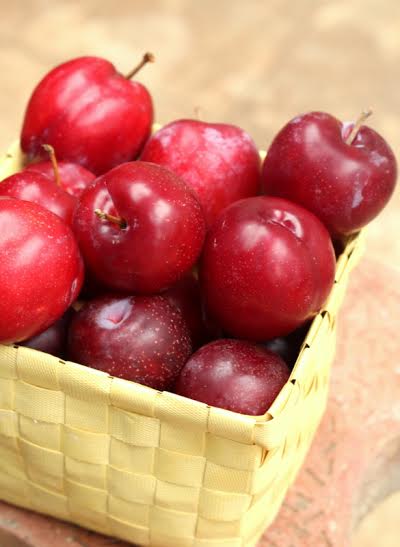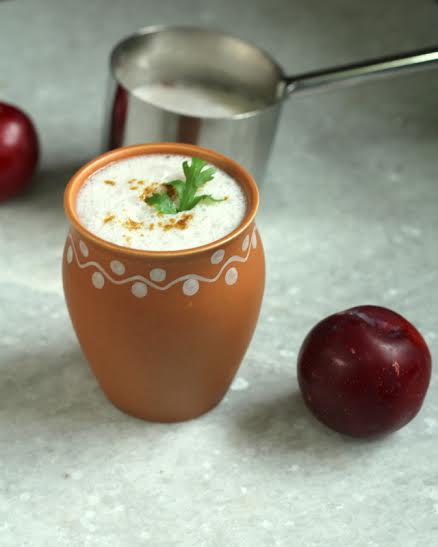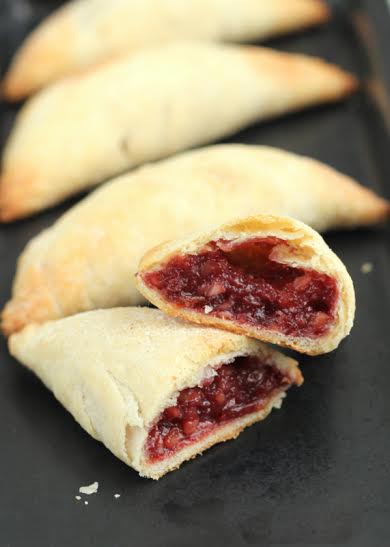Posts filed under ‘coconut’
Fasting and feasting- Bhagar (spicy Barnyard millet) and Danyachi (Groundnut) Amti
Bhagar and Danyachi amti is a typical Maharashtrian feast made during religious fasts.This spicy dish is a great gluten free meal option even on non-fasting days
Forbidden treat-Kavuni Arisi Payasam (Black Rice pudding)
Kavuni Arisi Payasam or Black Rice Pudding is a specialty of the Chettinad region of Tamil Nadu. This gorgeous deep violet hued sweet, is a prominent preparation of most festive fares of the Chettiars.
India’s Best blogger, Khadya Jatra and Khandeshi Cuisine
India’s Best blogger, Khadya Jatra and Khandeshi Cuisine….confused? …read on 🙂
2016 seems to have started on a very positive note! Betterbutter had organized ‘ India’s top blogger contest ‘.To participate we had to Curate a meal for two in a foodbook to make a complete meal. I participated and my foodbook menu included- Meetha Pan spritzer, Mini Thalipeeth Tostadas, Garam Masala spiced Palak Paneer Timbale and Meringue nests topped with Mango curd and fruits. 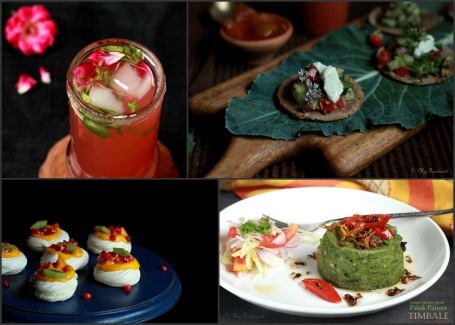
As you must have guessed by now, I won the India’s top blogger contest! The prize is as awesome as the concept & contest- a gorgeous orange coloured Le Creuset Casserole! Thank you again Betterbutter for this!
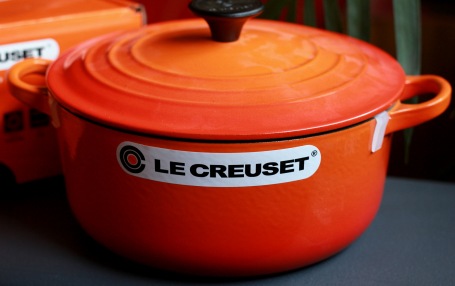
The recipes are already on the blog or you can check out the foodbook and some of my recipes here on betterbutter.
Khadya Jatra: I wrote this article for a Facebook group initiated by Saee of My Jhola– Angat Pangat, which re-discovers traditional Maharashtrian cuisine. We are starting with a new series on the group called ‘Khadya Jatra’ #APKhafyaJatra ,where a specialist of a particular sub-cuisine of Maharashtra will curate some background information about it and give an authentic recipe with step by step images.Members can then try out the recipe and thus get a chance to learn about the sub-cuisine and recipes.
I am fortunate to be the first ‘specialist’ and Saee invited me to curate some information and a recipe about Khandeshi Cuisine.Thank you Saee for this,I am honoured.
Spicy, fiery gravies with a thick sinful layer of oil floating on top (tarri) -that’s a trademark Khandeshi dish for you!
Nashik (where I stay) borders the Khandesh region (some parts of present Nashik district are part of Khandesh),has a strong influence of the Khandesi cuisine and you can see specialties like Misal and Shev Bhaji dished out at every nook and corner.
The quintessential Kala Masala forms the base of most gravies (rassa) along with dry coconut (khobra), onion and garlic. These are traditionally served with Bhakri or Rice.

Peanuts and peanut oil is also extensively used for cooking. Peanuts, small green lavangi mirchi or fiery Red mirchi, garlic are roasted on an iron griddle or directly on charcoal, pounded in a wooden mortar and pestle (Badgi-musal) to make the famed Thecha. Apart from the staple Jowar Bhakri, Kalnyachi Bhakri- Chutney is very popular with most Khandeshi’s. Kalna is a blend of Jowar + Urad and is served with a spicy peanut chutney.
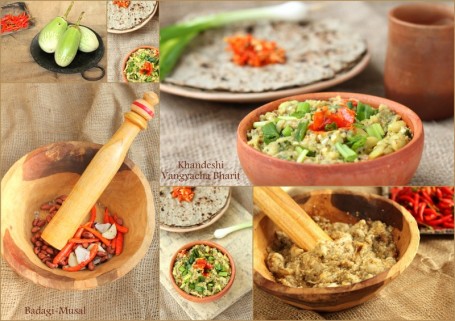
The Khandeshi love for eggplants need not be stressed. Be it Bharit made using large green eggplants (Jalgaoni Vangi) or small eggplants stuffed with kala masala or mashed eggplants (Ghotleli Bhaji), every Khandeshi loves this vegetable! The Ghotleli Bhaji and Dal batti are part of many festivities in most Khandeshi households.
Mande (Khandeshi version of Puran Poli) and Wheat Kheer are the popular sweets from the region.
The hot summers are utilized to make different types of Papads and Vade (Valvan) like the laborious yet rewarding Bibde.
A very popular Khandeshi preparation is Patodyachi (or Patvadya) Bhaji. Rolled out Besan flour dough is cut into strips and cooked in a spicy kala masala gravy. The other lesser known form of this preparation is called ‘Dubuk Vade’. Instead of making strips, dumplings are made from the besan batter and cooked in a similar gravy. I am guessing the name Dubuk comes from the noise it makes when a dumpling is dropped in the gravy-I am not sure of this though 🙂

It is simple, it is spicy, it is fiery, it uses Kalal masala gravy and it is absolutely lip smacking- ticking all the right boxes for typical Khandeshi, homestyle food. I have toned down the heat and oil to suit our taste; you can adjust it to yours.
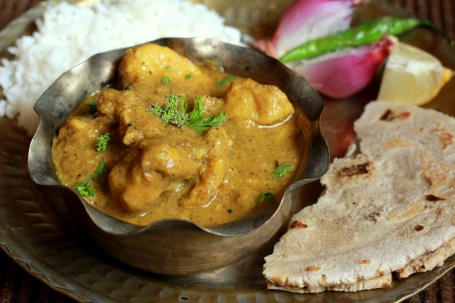
Here’s the recipe for Dubuk Vade
Recipe serves ~ 3-4 persons
Ingredients
For the Rassa
2 onions, sliced
¼ cup dry coconut, grated (Khobra)
4-5 garlic cloves
Handful of fresh coriander leaves, cleaned and washed
2 teaspoons Kala Masala (or to taste)
1 teaspoon Red chilli powder
½ teaspoon turmeric powder
2+2 tablespoon oil, divided (or more if you like)
2 teaspoon Cumene seeds (jeera)
Salt to taste
Water as required
For the vade (dumplings)
¾ cup Besan, sieved (gram flour)
2-3 garlic cloves, finely minced or grated
½- 1 teaspoon red chilli powder
½ teaspoon turmeric powder
¼ teaspoon asafoetida (hing)
Salt to taste
Method
To make the Rassa
Heat 2 tablespoon oil on an iron griddle or in an iron wok.
Add the onions and garlic and sauté till the onions start browning. Stir so that the onions and garlic are sautéed evenly.
Add the grated coconut and sauté till it just starts browning and starts emitting the aroma.
Add the coriander. Stir around to mix.
Take it off the heat and add the red chilli powder and kala masala.
Mix and cool completely.
Grind the masala, in a blender, using very little water to a smooth paste.
Heat the remaining oil in a saucepan/wok.
Add the cumin seeds.
Once they sizzle, add the ground masala and sauté.
Cook till the water evaporates and the oil starts oozing out, taking care not to burn the masala.
Add sufficient water (about 2 ½ -3 cups) to make a medium consistency gravy.
Season with salt and let the Rassa boil for a few minutes.
Meanwhile make the dumplings
Mix all the ingredients under dumplings. Add water to make a batter of dropping consistency (~ ½ cup)
Drop spoonfuls of the batter in the boiling Rassa, working quickly so that all the dumplings cook evenly. Add little water to the bowl/vessel in which you made the dumpling batter, whisk and add that to the gravy so that it will thicken a bit.
Cook for a few minutes till the dumplings are cooked through (about 8-10 minutes) and the gravy thickens a bit. (add water if it is too thick)
Serve hot with Jowar Bhakri or Rice, with a raw onion and lemon wedge on the side
Note: If you want that layer of oil floating on top, use more oil and chilli powder.
Modur Pulav for Regional Indian Home cooking series#1- a guest post by Anshie of Spice Roots
We are celebrating Nine years of Homestyle cooking at My Foodcourt! I have always been fascinated by the variety of the regional delicacies cooked in Indian homes. When I started blogging, we had a few events like the RCI that showcased regional cooking and which also introduced me to the different delicacies cooked in Indian homes. Instead of hosting an event, I thought of inviting my blogger friends from all over India and the world to share their classic, homestyle recipes.
I haven’t been fortunate enough to experience much of Kashmiri homestyle cooking, so I thought of kick-starting this series on Regional Indian Home cooking, with the heavenly Kashmiri cuisine. When I thought of picturesque Kashmir and its rich cuisine, I thought of my gorgeous friend, Anshie who blogs at Spice roots -where she writes about made from scratch recipes, immersed in spices and stories in order to help making eating home cooked food a lifestyle. I have been eyeing some of her recipes like Monji Hakh or the Monji Achar and plan to make them soon! Anshie was kind enough to accept my invitation instantly and brings to you a celebratory dish Modur Pulav from her homeland.Thank you Anshie for your lovely post, the fabulous recipe and the gorgeous photos.
Dear Readers, Please welcome Anshie and I hope you all enjoy discovering India’s culinary diversity through this series on Regional Indian Home cooking.
_________________________________________________________________________
Hi I am Ansh and I blog at Spiceroots. I write about made from scratch recipes, immersed in spices and stories in order to help making eating home cooked food a lifestyle. I hope to inspire a love for spices & home cooking and through my blog I try to stay connected to my roots.
Madhuli invited me over to be a guest at her cozy, beautiful blog space to celebrate Regional Indian Home cooking. She requested that I make a home style Kashmiri dish to introduce to you all. Since she is celebrating completing NINE years of food blogging, I decided to make a special dish from my home – Modur Pulav or the Sweet Pulav.
In Kashmir, Modur Pulav is how a feast begins. It is served as the first dish in any celebratory meal. Infused with cinnamon, cardamom, cloves and bayleaves, flavored with aromatic saffron; cooked in ghee and sugar and bejeweled with dried fruits and nuts and a heavy dash of peppercorns. The dish looks, feels and tastes celebratory! A little goes a long way, since it is really sweet and since it’s not a main dish.
I wanted this dish to hit all the right notes and though I have cooked the Modur Pulav a few times, I always thought it didn’t taste like my mom’s. So I looked up Anita’s Blog, A Mad Tea Party and found the missing ingredient from my dish. I was cooking it all along without the dried coconut. Once I found the missing link, I made it again and voila! So don’t skimp on the dried fruits and nuts. They are essential to the dish.
What better way to celebrate a friend and her accomplishments than share a treasured recipe from the place I celebrate everyday. I am glad to have connected with Madhuli through social media and her blog. Her love for food is showcased through her pictures and recipes. Thank you for having me over to share your space, Madhuli.
Modur Pulav Recipe:
Equipment – A Medium size pot with a tight fitting lid
Ingredients
2 c basmati rice
6 c water
1/3c Ghee
4 green cardamoms
½ Stick of cinnamon
4 cloves
½ C almonds
1/4 C sliced dried coconut
½ C raisins
4- 6 sliced dates
2 tej patta ( Indian bay leaf)
1 tsp peppercorns
2 C sugar
a big pinch of saffron
a pinch of sugar
3/4 C warm milk
Instructions
Wash the rice until the water runs clear. Drain and keep aside for a few minutes.
While the rice is resting, bring 6 cups of water to a rolling boil in a 5- 6 Qt pot.
Meanwhile, grind the saffron with the pinch of sugar and then add it to the warm milk.
Add in the rice into the boiling water and cook it to al dente (about 5 – 7 minutes) like you would for a biryani.
Drain and keep the rice aside.
Heat the ghee and add in the cloves, peppercorns, cardamom, bay leaves and cinnamon. Saute for a bit and then add in the nuts , dates and raisins. Add in the sugar and then add in the milk with the saffron. Cook until the sugar dissolves and you have a milky sugar syrup.
Using the same 6 qt pot as before, add the rice back into it. Now add the sugar syrup and nut mix into the rice. Stir to combine.
Cover and cook on low heat for 45 min to an hour. Alternately you can bake it in the oven at 350*F for 20 – 25 minutes.
A Plum post!
The thing that I like most about summers is the bounty of colorful fruits that it offers. Not just mangoes but Jamuns, Litchis,peaches apricots, cherries, plums we have been savoring them all! The lad is a fresh fruit lover and loves snacking on them. The little lady of our house on the other hand is a mango addict but refuses to eat any other fruit. The only way to feed her fruits other than mangoes and bananas is to sneak them in shakes or smoothies.
The gorgeous weather (yes finally it’s raining here!) has increased the frequency of the kids’ hunger pangs. That also means my mind is constantly thinking of recipes to satiate the ever hungry kids with ‘different’ yet wholesome food. (I wonder how my mother managed when we were growing up?)
Litchis went into salads and Granitas when it was warmer. Peaches/apricots in crisps and parfaits.
Plums were a bit tricky to sneak in -since the boy loves tart fruits but no sweets for him. The daughter wont eat tart fruits but loved her sweets.
I had some leftover coconut milk from a Thai curry made earlier. On a whim I decided to make Sol Kadhi sans the Sol-The kokum. So you can call this ‘Plum Kadhi’ instead. The end result was as appetizing as the quintessential Maharashtrian favourite Sol Kadhi (have blogged about it here earlier).
Plum Kadhi recipe
Makes ~ 4 cups
Ingredients
1 1/2 cups Coconut milk
~ 2 1/2 cups water
2 Plums pitted and chopped
¼ tsp green chilli paste
¼ tsp garlic paste
Black Salt to taste
Cumin powder and coriander or mint leaves for garnishing
Method
Blend all the ingredients except cumin and coriander/mint leaves together.
Chill and Garnish with cumin powder/coriander/mint leaves.
To satisfy the little on I made Plum Karanji-handpies. I chose to bake instead of deep fry the local favourite sweet Karanji with a Plum twist. A layered cover (also called as Satha/Sathyachya karanjya in Marathi) wherein I substituted half the quantity of all purpose flour with whole wheat flour and filled it with a sweet and sour plum filling. The end result was a stunning (specially when cut), crisp karanji with an unsual sweet -sour taste- almost a cross between a karanji and a hand pie and hence they are Plum Karanji-handpies !
Plum Karanji recipe
Makes ~ 6 Karanjis
Ingredients
For the cover
¾ cup All purpose flour
¾ cup Whole wheat flour
3 tsp fine semolina
4 tbsp ghee melted
2 tsp icing sugar
Pinch of salt
~ ½ cup milk or enough to knead a tight dough
For the filling
7-8 Crisp plums, pitted and chopped
3 tbsp scrapped fresh coconut
2 tbsp crushed/powdered cashewnuts
¼ tsp clove powder
¼ tsp cinnamon powder
~ 6 tbsp powdered jaggery (or to taste)
For layering
4 tsp ghee
2 tsp Cornflour
Cinnamon sugar for dusting (optional)
Method:
For the filling:
In a pan add the plum, coconut and jaggery. Cook on a low flame till the liquid evaporates (~ 4-5 minutes)
Add the cashewnut powder and the spices.
Mix well and cool completely.
For the layering mixture:
Whisk the ghee a few times till it becomes fluffy.
Add cornflour and whisk again.
For the Cover
In the bowl of the food processor add all the cover ingredients except the milk. Pulse 1-2 times
Add the milk slowly till a firm dough is formed. Knead into a ball.
Cover and keep aside for half an hour.
Halfway through the waiting time heat the oven to 180 deg C.
After half hour, cut the dough into 4 equal parts.
Form a ball of 1 dough piece and roll out into a thin circular disc ~ 6 inch diameter
Keep aside, covered.
Roll out the 2nd dough ball to a thin circular disc like a chapati.
Spread about a tsp of the ghee cornflour mixture evenly on the rolled out dough.
Cover this with the rolled out chapatti no 1.
Repeat the with the 3rd and 4th dough ball. Total you have 4 rolled out chapatti like discs layered with the ghee-cornflour mixture.
Put a tsp of the cornflour-ghee mixture on top of the 4th layer.
Make a tight roll of the layered chapattis, like a Swiss roll.
Trim both the edges and cut the rest of the roll into 6 pieces approximately 1 inch each.
Cover the other cut pieces till you roll out and fill the first one
With the cut side down roll out each piece into a circle like a poori
Place 1 tsp of the plum filling in the centre of the poori
Cover one side of the poori with the other into a semicircle-karanji shape.
Seal the ends using a fork or a fluted cutter
Place on a greased baking tray and bake till golden in color (~ 15 mins)
Dust with Cinnamon sugar mixture (optional)
Serve hot
With just 10 days to go for the first Indian Food Bloggers Meet ,the IFBM FB page is abuzz with all the upcoming excitement.There are several contests for participating bloggers being held as a run-up to the actual meet.
I am sending the ‘Plum Kadhi‘ and the ‘Plum Karanji Handpies‘ to the KitchenAid Plum contest
Tomato Saar
Tomato Saar is a quintessential Maharashtrian preparation, also a ‘must have’ dish for most of our festive fares.
Tomato is paired with coconut and then tempered with a few spices to make a sweet-spicy-tangy ‘soup’ usually as an accompaniment to steamed rice, although it can also be served like a soup on its own.
Every Maharashtrian household has a ‘unique’ recipe for Tomato Saar. This recipe is my mom’s and I have followed exactly as she makes it. (I am surprised that after all these years I have missed blogging about it here on My Foodcourt!)
In other news, after my earlier rant about the camera, the DSLR is finally home and being played with. I am still discovering the unlimited features, so you will soon see a lot of my ‘discoveries’ with the same either here on the blog or on the FB page here.
Back to my mom’s recipe for Tomato Saar:
(This makes about 13-14 cups of saar)
Ingredients
9-10 medium sized ripe red tomatoes
3/4th cup fresh grated coconut
2 ½ tsp grated jaggery (or more according to sweetness desired)
½ tsp red chilli powder (optional)
Salt to taste
For the tempering:
2 tsp Ghee/oil (homemade ghee tastes the best)
1 tsp mustard seeds
1 tsp cumene seeds
1/4 tsp asafetida (a pinch)
1-2 dry red chillies broken into pieces
10-12 curry leaves torn into pieces with hand
Chopped coriander leaves for garnishing
Method:
Cook the tomatoes in a pressure pan until soft and they lose their ‘rawness’ (one whistle and then 5 mins on sim)
Meanwhile grind the coconut to a fine paste using little water.
Once the tomatoes are cooked, cool and remove skin and chop off the head.
Grind the tomatoes along with the coconut to a smooth paste. The coconut and tomatoes should blend together.
You can sieve the paste through a mesh at this stage. I like to skip this step and directly use the paste as it is.
Add sufficient water to the paste to bring it to a soupy consistency.
Add the jaggery,salt and chilli powder and bring it to a boil.
In a small pan/kadai, heat the ghee/oil.
Add the mustard seeds.
Add the cumene seeds once the mustard seeds splutter.
Switch off the gas and add the asafetida, curry leaves and the red chillies.
Add this tempering to the saar.
Garnish with fresh chopped coriander leaves and serve with hot rice or just as it is like a soup.
5 years of Blogging and My Mom’s Puran Poli with Katachi Amti
Puran Poli is a quintessential Maharashtrian delicacy and you may wonder how it has not featured on My foodcourt in the past 5 years. Yes, My Foodcourt turned 5 this August! I have been neck deep in work, kids and the daily grind. August and now September just zoomed past me and I just realized that it’s been fabulous 5 years of blogging; sharing and interacting with my virtual friends! Its late but we are celebrating nevertheless 🙂
Many festivals in Maharashtra like Holi, Gudi Padwa, Gauri-Ganapati Puja,Dassera feature the Puran Poli as its star attraction, as far as the festival food is concerned. The skills of a good Marathi cook are gauged by the way he/she can make the Puran Poli. My dad is a very good cook and to explain effectively his cooking skills I just say that he can make good Puran Poli’s and Bhakris! I don’t have to say anything else, it’s understood that he is indeed a very good cook 🙂
Regular readers of this blog know that I don’t have a weakness for sweets, in fact far from that and maybe that’s the reason why Puran Poli has not been featured on My Foodcourt. My mom makes one of the best Puran Polis and even I cannot resist eating her Puran Poli. She uses some fresh coconut and Khoya/Khawa/Mawa in addition to the usual Chana dal for the filling to enhance the richness and flavor. The proportion of jaggery and sugar is just apt for my taste buds.
I got a chance to capture the Puran Poli making process this time when I stayed over at my parents place during the Gauri- Ganapati festival. The consistency of the Puran/stuffing, the dough and the skill of rolling them out determine the resultant nature of the Puran Poli. With a little bit of practice you can make decent Puran Polis. The amount of effort put into making Puran Poli is worth every bit.
My Mom made it for many people (~40 Puran Polis) and hence the proportions appear in kg. You can scale it to your requirement. She made the Puran a day in advance, so she didn’t have too much work the next day. Also the left over Puran can be stored in the freezer in a sealed bag/container and used as and when required.
The Puran Poli is usually served with Katachi Amti , made from the leftover stock from cooking the Chana Dal. The stock is spiced up with different masalas to balance the sweetness of the Puran Poli.
Note: This is an indulgent sweet and needs all the oil, ghee, sweetness and richness that is mentioned below. So make this when you are not too conscious of the calories being consumed 🙂
Here’s celebrating 5 years of My Foodcourt with my Mom’s Puran Poli recipe:
My Mom’s Puran Poli recipe
For the Puran (Stuffing)
1 kg Chana Dal
½ tsp Turmeric
¾ kg Jaggery
3/4th Katori Sugar (my mom uses a katori/Vati to measure for her measurements)
200 gms Khoya/ Khawa/Mawa ( you can use Pedhas)
½ medium sized freshly grated coconut
Nutmeg powder ½ tsp (optional)
For the covering Dough:
½ kg Wheat Flour
1 tbsp All purpose flour
Pinch of salt
Oil as required
Rice Flour for dusting the Puran Poli
Method:
For the Puran (Stuffing)
Cook Chana Dal with twice amount of water, with turmeric in a pressure cooker till very soft but not mashed. (about 2 whistles and ~15 mins on low flame thereafter.)
Meanwhile roast the Khoya in a pan on low heat till slightly pink/very light brown.
Grind the Coconut in the mixer to a fine paste without adding water.
Drain and remove water from the cooked Dal and reserve the water.
Heat a kadhai and add the dal and on a low flame dry out all the moisture from the Dal.
Add the jaggery, sugar, coconut paste, roasted Khoya to the dal.
Cook and stir till the mixture is completely dry. (take care not to burn the mixture)
Add the nutmeg powder mix well.
Remove the mixture from the heat and pass it through a Puran press/ Food Mill.
Keep aside till you are ready with the covering dough. This filling can be made 1-2 days in advance and stored in an airtight container in the refrigerator.
For the Covering Dough:
Sift the wheat flour and the all purpose flour and pinch of salt through a fine mesh sieve.
Add oil (2-3 tbsp) and water and knead into a soft elastic dough. (You may need to add more water/ oil to get very soft dough)
Keep the dough covered for about an hour.
After an hour add about 3/4th Katori oil, salt and little water to make it more soft.
Take a lemon sized ball of the dough. Flatten it using the finger tips with the help of the Rice flour
Take a bigger ball of the Puran/stuffing mixture.
Place it on the flattened dough,seal and cover it with the dough such that the Puran gets stuffed inside the dough.
Roll out the stuffed dough using the Rice flour for dusting into a round chapatti (as thin as possible), taking care that the Puran/stuffing does not come out and the chapatti does not stick to the surface.
Heat a non-stick tava/griddle.
Once rolled out, use the rolling pin to transfer the Puran poli to the tava.
Cook on both sides till golden brown.
Remove from the tava.
Serve hot Puran Poli’s with a generous drizzle of hot melted ghee and Katachi Amti (recipe below).
Katachi Amti Recipe:
Stock/water left over from cooking the Chana dal for Puran (above) add water if required to make it thinner.
3-4 cloves
4-5 Black pepper corns
1-2 tsp Mustard seeds
1-2 tsp cumene seeds
7-8 curry leaves torn into pieces with hand
1 tsp grated jaggery
1 tsp tamarind pulp
1 tsp Maharshtrian Kala Masala or Garam Masala
~4-5 tbsp chopped fresh Coriander leaves
Salt to taste
2 tbsp oil
Method:
Heat the oil in a deep pan.
Add the mustard seeds.
Once they splutter, add the cloves and peppercorns fry 1-2 second and then add the cumene seeds.
Add the curry leaves and the coriander leaves.
Add the Kat/stock .
Add the jaggery, tamarind pulp, Masala and season with salt. (you can adjust the proportion of jaggery and tamarind to your taste.)
Bring it to a boil and serve hot with Puran Poli.
Stay Tuned for a fabulous Giveaway coming soon on MyFoodcourt!
Pepper away the Monsoon blues with this quick and simple Black pepper Rasam/soup
The medicinal uses of Black pepper are well known. It is one of the trusted home remedies for cold and cough. We have been surviving the Monsoon bug by adding this ‘natural antibiotic‘ to our day-to -day meals.
We are having this hot spicy Pepper Rasam/ soup almost every day to soothe our itchy throats; a soothing balm to ‘shoo’ away the Monsoon blues.
This is of course my Mother-in-law’s recipe and uses very few day-to-day ingredients; Black pepper-cumene seeds –some dried coconut and curry leaves. You can make a ready spice mix and store in an airtight container. Whenever you want to make the rasam just boil some lentils add the ready spice mix and viola! your ‘magic potion’ is ready in minutes
Here’s the recipe for Pepper Rasam/Soup
Things required:
¼ cup Toovar Dal (pigeon pea lentils)
8-10 Black pepprcorns
~2 tsp Cumene seeds
~ 1 tbsp dried coconut grated
4-5 curry leaves
Pinch of turmeric and few drops of oil to cook the Lentils
Salt to taste
1 tsp homemade ghee
Method:
Pressure cook the dal with ~ 2 ½ cups of water, a pinch of turmeric and 3-4 drops of oil.
In a pan dry roast black peppercorns, cumene seeds, dried coconut and curry leaves one by one.
Cool and coarsely grind the spices in a mortar and pestle.
Heat ghee in a deep pan.
Add the spice mix.
Add the cooked dal along with the water. Adjust the consistency of water to your liking.
Season with salt and boil for few minutes.
Serve piping hot.
Notes:
You can adjust the spices to your taste, it is a very forgiving recipe.
You can skip the ghee if you don’t want it, just mix the spices and the dal and boil together.
If you plan to serve this as a clear soup, let the soup stand for a few minutes and then just pour out the liquid. You can use the leftover dal to make some dal parathas or sambar
You can zest up the soup with a dash of lime juice
Comfort food-Poha(beaten rice) spiced with Methkut
I was feeling a bit under the weather for the past few days. The wet rainy days did not help to lift up my spirits. Elaborate cooking took a back seat and it was time for some quick easy meals.
Poha (beaten rice) is a must-have ingredient for all Maharashtrian pantries. It is a regular item on the ‘essential items’ in the monthly grocery list. Poha is a handy ingredient when you have unexpected guest, you are pressed for time, need a quick meal or when you want some comfort food!
The modest Poha is dressed up here with a few spices and a classic Methkut powder to make one of the most delightful comfort foods for me.
The recipe is quite forgiving and does not need any pre-planning. Day-to-day ingredients are used and it can be made at the last minute.
The key ingredient used to flavor this Spicy Poha is a Methkut. Methkut is a classic powder made from a few dals and spices and is used in most Maharashtrian households to flavour soft cooked rice; again a comfort food and one with lot of childhood memories.
I used readymade Methkut powder but you can find recipes here and here.
This spiced Poha makes a great tea time snack along with a cup of spiced Chai or a glass of freshly brewed filter coffee.
Here’s the recipe:
2 cups Thin poha (beaten rice)
2-3 tbsp Methkut powder
3-4 tsp coconut water /buttermilk/milk or just plain water
Pinch of sugar
Salt to taste
For the tadka (tempering):
A handful of peanuts
A handful of roasted Chana dal (Dalia)
4-5 dry Red chillies cut into pieces
4-5 curry leaves torn into pieces
1 tsp mustard seeds
1 tsp cumene seeds
½ tsp turmeric powder
~2-3 tbsp oil
For the garnish:
Lime Juice
Fresh coriander leaves
Method:
Sprinkle coconut water/buttermilk/milk or just plain water on the poha and mix to make it a little moist.
Add the methkut, salt and sugar and mix nicely to coat the poha. (Adjust the amount of Methkut to your taste).Keep it aside.
Heat oil in a small pan.
Add the mustard seeds and once they splutter add the cumene seeds followed by the peanuts.
Fry the peanuts well and then add the roasted chana dal.
Add in the turmeric powder, Red chilles and curry leaves.
Add this tadka\tempering to the poha and mix nicely.
Keep covered for a ~ 5 minutes for all the flavours to mingle.
Garnish with lime juice and coriander leaves.
Variation: If you cannot find Methkut you can use the Chutney podi which is normally served with dosa.
Or I have blogged about another version of spicy Poha (Dadpe Pohe) earlier on My Foodcourt here.
Also see Poha spiced with Tamarind
Monsoon Magic-Minty Dal Vada
Dark clouds, light showers, gentle breeze; spent the most magical weekend lounging in front of the TV with hot spicy food and Ginger Chai.
Our garden now wears a fresh green coat. Flowers bloom and my herb garden is alive again! The Monsoon has brought fresh new life to the surroundings.
This Minty Dal Vada is a rainy day ‘comfort food for the soul’!Mint, Coriander, green chillies, and ginger together lend a delectable flavor to these crunchy Chana Dal (Bengal gram) fritters. The hot spicy Vadas are a perfect tea time snack accompanied by a cup of fresh ginger tea or are great party starters.
Here’s the recipe:(recipe source- my Mother-in-Law)
Minty Dal Vada recipe
3 cups Chana dal soaked in water for 2-3 hrs
1 cup grated fresh coconut
1 bunch mint leaves cleaned, washed and chopped
Few coriander sprigs,
1” piece ginger chopped,
8-10 green chillies chopped (or as spicy as you like)
2 small onions finely chopped
Salt to taste
Oil for deep frying
Drain the water from the Dal. Spread on a kitchen towel to soak up the moisture.
Coarsely grind the Chana dal with the salt, coconut, mint, coriander, green chillies and ginger. (Do not grind to a fine paste)
Just before frying add the chopped onions and mix well.
Shape lemon sized balls of this mixture to small patties like fritters.

Deep fry on medium heat till golden brown.
Serve hot immediately.No accompaniments necessary!
Note: As a variation you can substitute the Mint with other herbs like dill.






